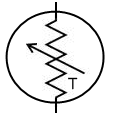What is a Thermistor?

A thermistor is a thermally sensitive resistor whose resistance value changes with changes in operating temperature.
Because of the self-heating effect of current in a thermistor, the device changes resistance with changes in current.
Thermistors exhibit either a positive temperature coefficient (PTC) or a negative temperature coefficient (NTC). If a thermistor has a positive temperature coefficient, its resistance increases as the operating temperature increases. Conversely, if a thermistor has a negative temperature coefficient, its resistance decreases as the operating temperature increases.
How much the resistance changes with changes in the operating temperature depends on the size and construction of the thermistor. It's always best to check the datasheet of the thermistor in use to find out all the specifications of the thermistors.
Note that the resistance of thermistors does not undergo instantaneous
changes with changes in operating temperature. A certain time interval, determined
by the thermal mass (size) of the thermistor, is required for resistance change. A thermistor
with a small mass will change more rapidly than one with a large mass.

The symbol to the right is the schematic symbol of a themistor. Notice
the arrow through the resistor symbol and the letter T within the circle. The arrow indicates
that the resistance is variable as the temperature T changes.
Thermistors are frequently used in electronic circuits that handle temperature
measurement, temperature control, and temperature compensation.
To see how a temperature-sensing circuit can be built with a thermistor, see How to Build a Simple Thermistor Circuit.
Related Resources
How to Test a Thermistor
Thermistor Resistance- Explained
How to Build a Heat Alarm Circuit
What is Sensible Heat?